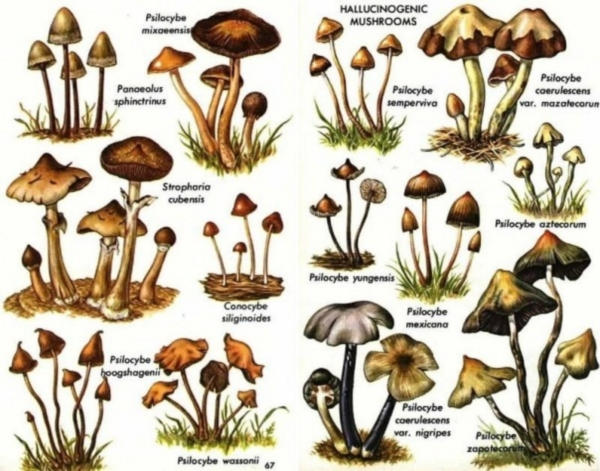Psilocybin Microdosing Movement: An Overview
Psilocybin is a tryptamine alkaloid (not related to the word “trip”) found in certain types of mushrooms. The most common species is Psilocybin Cubensis. While naturally occurring, this species is popular in Russian drug culture among “growers” because it is relatively easy to cultivate indoors. In Mexico and Argentina, it is also widely used, though not the only variety available. Here, we’ll focus on Psilocybin Cubensis, specifically its use as a nootropic in the form of dried mushrooms.
In recreational and shamanic practices, the mushrooms themselves are used, while medical research typically employs synthetic psilocybin. Pure psilocybin can be synthesized at home, though this is illegal in Russia.
How Psilocybin Works
Psilocybin loses its phosphate group and becomes psilocin (which is also present in small amounts in some mushrooms). Psilocin (4-OH-DMT) is the tryptamine that actually affects the brain, but it is unstable, so research uses psilocybin, which is converted to psilocin in the body. Both are classified as serotonergic psychedelics. Serotonin (5-HT) is a key neurotransmitter and also a tryptamine.
Note: If mushrooms are consumed with the amino acid 5-HTP (5-hydroxytryptophan), the effect is enhanced because the body has more resources to produce serotonin.
Psilocybin acts as an agonist of serotonin receptors, specifically 5-HT2A (linked to hallucinations), 5-HT2C, and 5-HT1A. Psilocin interacts with these receptors differently than serotonin does. Psilocybin has minor effects on dopamine and norepinephrine, but these are much less significant.
Brain Regions and Their Effects
The effects of 4-OH-DMT are most pronounced where these receptors are concentrated. Since 2012, Dr. Carhart-Harris’s team has conducted fMRI studies showing that psilocybin reduces activity in the thalamus, anterior cingulate cortex (ACC), and posterior cingulate cortex (PCC). Decreased activity in the ACC and medial prefrontal cortex (mPFC) correlates with the intensity of subjective psilocybin experiences.
- PCC: Associated with self-reflection, attention, and is hyperactive in conditions like depression, PTSD, brain injuries, and anxiety disorders.
- mPFC: Plays a key role in arousal, inhibition, decision-making, social cognition, and fear modulation.
These regions are part of the Default Mode Network (DMN), which is highly active when the mind is at rest. Psilocybin suppresses DMN activity, allowing for increased communication between other brain regions. A 2014 British study showed that psilocybin changes the connections between different brain structures, as seen in comparative brain scans.
Organizations and Resources
Two major organizations are bringing psychedelics back into U.S. medical culture:
- MAPS (Multidisciplinary Association for Psychedelic Studies): Focuses on MDMA for PTSD treatment.
- Heffter Institute: Focuses on psilocybin for addiction, depression, and anxiety in cancer patients.
Recommended resources:
- Heffter Institute Research
- MAPS YouTube Channel
- MAPS Research
- Erowid – Extensive information on psychoactive substances
- Shroomery – Comprehensive mushroom resource
- Reddit r/shrooms – Community discussion
Microdosing: Concept and Dosage
The term “psycholytic doses” was coined by Stanislav Grof, who used small doses of psychedelics (mainly LSD) to treat various mental disorders. The idea is to take microdoses of psychedelics to enhance cognitive function without causing negative or psychedelic effects.
Recommended Dosage
- For psilocybin: 0.1–0.5 grams of dried mushrooms
Frequency
- At least every other day is recommended. For creative tasks, taking a microdose in the middle of a social event (without alcohol or heavy food) can be especially effective.
Personal Experience with Microdosing
0.3 grams Psilocybin Cubensis
No side effects. Helped with focus, prioritization, and reduced distractions. Enhanced social skills, positivity, and engagement in communication. No lingering effects the next day.
0.6 grams Psilocybin Cubensis
Mild side effects (slight nausea, heaviness in the head, cool sensation). Felt like a race car in neutral—potential was there, but not overwhelming. Physical effects made focusing harder, but no motor or visual distortions.
0.8 grams Psilocybin Cubensis
Taken at work (not recommended). No intense psychedelic effects, but found it impossible to focus on work tasks, which lost all meaning. Mood was positive and playful, but there was some discomfort in the head.
Additional Microdosing Tips
- Avoid sweets (they can distract your stomach).
- Drink yogurt or kefir when consuming mushrooms.
- Consider taking “5-HTP 100 mg” (NOW brand) on an empty stomach 30 minutes before and after dosing.
- Do not smoke anything during the experience.
- Stick to 0.3–0.5 grams of dried mushrooms; adjust individually.
- Do a 20-minute stretching session before dosing. You’ll become more aware of your body and muscle tension.
References
- DMT Nexus
- American Scientist PDF
- BMJ Open
- PubMed 25744618
- Erowid: Mushroom Chemistry
- JAMA Psychiatry
- PubMed 26074742
- JPET
- PNAS
- Brain Journal
- YouTube: CNR4o5JZEi0
- Psixologiya.org
- Neuron
- Frontiers in Human Neuroscience
- Wikipedia: Default Mode Network
- Royal Society Interface
- Aldous Huxley: The Doors of Perception
- PubMed 23727882



